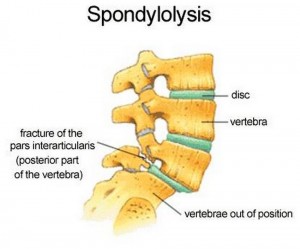Spondylolysis
Posted on November 19th, 2015 by Andries Lodder
What is it?
Spondylolysis means spine defect and is the degeneration of the vertebra. This defect occurs mostly in the pars interarticularis of the articular processes of the vertebrae. This defect or crack mostly occurs in lumbar area of the spine, L4 to L5, due to repeated strain.
Spondylolysis has a higher prevalence in children, especially boys, and young athletes than in adults due to the still ongoing development of the spine. In children, the highest prevalence is in the 5 to 7 year age group and in the 11 to 16 year age group as there is a marked increase in activity. Sports which cause hyperextension of the spine will have a higher incidence of spondylolysis. The site of the fracture is usually on the opposite side to which the activity is being performed.
What causes it?
Spondylolysis can be caused from congenital factors as one can be born with a weakness of the pars interarticularis. It can be cause by trauma or overuse syndrome which results in a stress fracture.
Signs to look out for?
Spondylolysis is often asymptomatic in the morning, but becomes worse with activity. Patients may complain of a continual mild to moderate muscular pain or stiffness across the lower back. This area feels tired and fatigues easily. Pain is aggravated by lumbar extension movements and may have associated spasm of the hamstring muscles. By changing positions often the patient achieves a form of relief from the pain.
What Rehabilitation to do?
Treatment depends on age and the severity of the injury. Treatment tends to be mostly conservative in nature, especially with spondylolysis. Conservative treatment should always be attempted first. Activity causing the pain should be restricted.
The prevention and rehabilitation programme provided by your Biokineticist have the same goal – Strengthen the core.
Focus will be on the area of the spine which has become hyper mobile. This area needs to be stabilized. Complexity of the exercises should be increased, not the repetitions. Core exercises should be dynamic. Hamstring and gluteal muscle need to be stretched, while abdominal muscles need to be strengthened. All exercises and stretches must be done in a pain free range of motion.
Tweet
